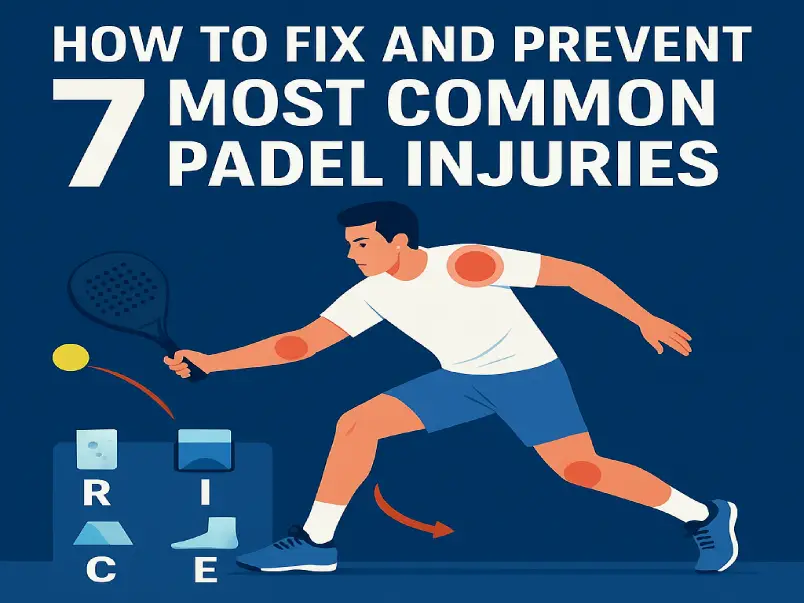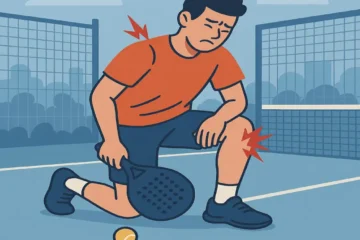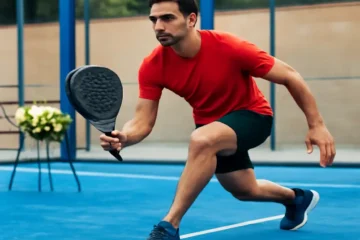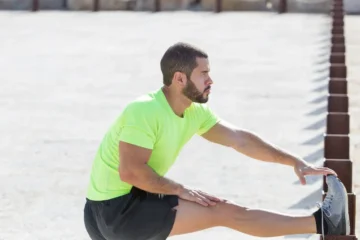Why Padel Players Get Hurt
Padel is one of the fastest-growing sports in the world — a thrilling mix of tennis, squash, and strategy. It’s fast, social, and addictive, making it easy to see why millions of players are hitting the courts every week. But while the sport’s explosive rallies and dynamic movements are part of its charm, they also come with a risk: padel injuries.
Here’s the paradox — padel feels accessible to anyone, but that sense of ease often leads to overconfidence and overlooked preparation. Without the right warm-up, strength work, and recovery habits, even casual players can find themselves sidelined with pain in the elbow, knees, or shoulders.
The good news? Most padel injuries are completely preventable. With smart training, proper recovery, and a little body awareness, you can stay strong, agile, and pain-free.
This guide breaks down the 7 most common padel injuries, how to fix them, and — most importantly — how to stop them from happening again.
Key Message: Prevention isn’t just protection; it’s empowerment. By learning how to move, warm up, and recover like a pro, you’ll keep your game sharp and your body strong.
Part 1: Understanding the Demands of Padel
Before we dive into specific injuries, it’s important to understand what makes padel physically demanding.
Padel is a sport of short, explosive movements — quick sprints, lunges, jumps, and sudden direction changes. You’re constantly starting, stopping, twisting, and stretching for the ball. Every point tests your coordination, reaction speed, and balance.
Here’s what makes padel particularly tough on the body:
- Explosive movements: The constant acceleration and deceleration strain muscles and joints, especially in the knees and ankles.
- Overhead shots: The repetitive smashes, bandejas, and viboras put heavy stress on the shoulders.
- Low-to-high dynamics: Constant bending for low shots challenges the hips, back, and hamstrings.
- Core engagement: The core is your stabilizer. Without good core strength, the lower back and shoulders compensate — often leading to overuse injuries.
Understanding these movement patterns is the first step toward prevention.
Part 2: The 7 Most Common Padel Injuries (and How to Fix Them)
Let’s look at the seven injuries most padel players face, what causes them, and how to recover safely.
1. Tennis Elbow & Golfer’s Elbow (Epicondylitis)
What it is:
Inflammation of the tendons on the inside (Golfer’s) or outside (Tennis) of the elbow. It’s one of the most frequent padel injuries, especially for new or overenthusiastic players.
Why in Padel:
Repetitive swings and late contact with the ball create excessive strain on the forearm muscles and tendons. Backhand shots and poor technique worsen it.
Symptoms:
A dull ache or sharp pain on the outside or inside of the elbow, especially when gripping the racket or lifting objects.
Fix & Recover:
- Rest and ice the area for 15–20 minutes several times a day.
- Use a brace or forearm strap to reduce tension.
- Strengthen your forearms with eccentric wrist curls and grip exercises.
- Massage and stretch the forearm muscles regularly.
Prevention Tip:
Use a racket with a comfortable grip size and low vibration. Warm up the wrists before playing.
2. Rotator Cuff Tendinitis
What it is:
Inflammation of the tendons that stabilize your shoulder joint.
Why in Padel:
The repetitive overhead motion of smashes, bandejas, and serves irritates these tendons. Players with poor posture or weak shoulder stabilizers are at higher risk.
Symptoms:
Pain when raising the arm overhead or lying on the affected shoulder.
Fix & Recover:
- Rest from overhead shots for several days.
- Apply ice after play to reduce inflammation.
- Do rotator cuff strengthening exercises with resistance bands (external rotations, scapular squeezes).
- Improve shoulder mobility with stretching.
Prevention Tip:
Include shoulder warm-ups like arm circles and band pull-aparts before every match.
3. Knee Pain (Patellar Tendinitis & Meniscus Issues)
What it is:
Pain in the front or sides of the knee due to inflammation of the patellar tendon (“jumper’s knee”) or cartilage irritation (meniscus issues).
Why in Padel:
The constant lunging, squatting, and rapid deceleration puts heavy load on the knees. Hard court surfaces amplify the impact.
Symptoms:
Sharp or dull pain when jumping, changing direction, or climbing stairs.
Fix & Recover:
- Strengthen the quadriceps, hamstrings, and glutes with squats, lunges, and step-ups.
- Use ice and compression to control swelling.
- Consider knee taping or braces for added stability.
- Wear quality padel shoes with cushioning and grip.
Prevention Tip:
Avoid playing on wet or slippery surfaces. Incorporate strength and flexibility training into your weekly routine.
4. Ankle Sprains
What it is:
Stretching or tearing of the ankle ligaments due to a sudden twist or misstep.
Why in Padel:
Fast side-to-side movements and unexpected ball deflections increase the chance of rolling your ankle — especially if you accidentally step on the ball.
Symptoms:
Swelling, bruising, and difficulty bearing weight on the foot.
Fix & Recover:
- Apply the RICE protocol: Rest, Ice, Compression, Elevation.
- Avoid walking or playing until you can move pain-free.
- Rebuild strength with balance exercises (e.g., standing on one leg, wobble board).
Prevention Tip:
Always wear padel-specific shoes with strong lateral support and avoid playing when fatigued.
5. Calf and Achilles Strains
What it is:
A partial tear or overstretching of the calf muscle or Achilles tendon.
Why in Padel:
Explosive pushes, quick take-offs, and awkward landings overstretch the lower leg.
Symptoms:
Sudden pain or tightness in the calf, sometimes accompanied by a “pop” sound.
Fix & Recover:
- Immediate RICE treatment.
- Gradual stretching and gentle massage after initial healing.
- Perform eccentric heel drops to strengthen the Achilles tendon.
Prevention Tip:
Warm up your calves properly before play and don’t skip cool-down stretches.
6. Lower Back Pain
What it is:
Strain or irritation of the muscles and discs in the lower spine.
Why in Padel:
Repetitive twisting, bending, and hyperextension (especially during smashes) can overload the lumbar spine.
Symptoms:
A dull ache or sharp pain in the lower back, sometimes radiating to the hips.
Fix & Recover:
- Rest and avoid heavy twisting for a few days.
- Strengthen the core and glutes (planks, bird-dogs, glute bridges).
- Improve hip flexibility with dynamic stretches.
Prevention Tip:
Keep your core engaged during play and maintain a neutral spine posture during serves and smashes.
7. Shoulder Bursitis
What it is:
Inflammation of the bursa — the fluid-filled sac that cushions the shoulder joint.
Why in Padel:
Overuse from repeated overhead swings causes friction and swelling.
Symptoms:
Aching shoulder, pain when lifting the arm, or a “clicking” sensation.
Fix & Recover:
- Rest from overhead shots.
- Use anti-inflammatory creams or medication if recommended.
- Focus on shoulder mobility and posture correction.
Prevention Tip:
Don’t skip shoulder warm-ups, and alternate between smashes and softer shots when possible.
Part 3: Your Ultimate Padel Injury Prevention Plan
Now that we’ve covered the common injuries, let’s focus on how to prevent them altogether. Injury prevention in padel comes down to three pillars: mobility, strength, and recovery.
1. The Non-Negotiable Warm-Up (5–10 Minutes)
A proper warm-up preps your muscles, joints, and mind for the dynamic movements of padel.
What to do:
- Dynamic stretching: leg swings, torso twists, arm circles.
- Light cardio: jogging, skipping, or quick footwork drills.
- Padel-specific movement: mimic forehand, backhand, and volley motions.
A warm body performs better and reacts faster — and it’s your best defense against strains.
2. The Power of the Cool-Down (5 Minutes)
Most players rush off the court after a game — big mistake. Cooling down helps the muscles relax, reduces next-day soreness, and accelerates recovery.
What to do:
- Static stretches: hold for 20–30 seconds each (quads, hamstrings, calves, shoulders, chest).
- Deep breathing: lowers heart rate and aids recovery.
Your body will thank you the next morning.
3. Strength and Conditioning is Your Secret Weapon
Building a stronger, more balanced body helps prevent overuse and sudden injuries.
Core Work:
- Planks, Russian twists, and side planks for stability.
Lower Body:
- Squats, lunges, and single-leg exercises protect knees and ankles.
Upper Body:
- Resistance band shoulder rotations and scapular retractions improve shoulder endurance.
Balance:
- Add single-leg stands or stability ball work to train proprioception.
4. Technique is the Best Prevention
Bad habits cause more injuries than bad luck.
- Learn proper swing mechanics from a certified coach.
- Use your legs and core to generate power, not just your arm.
- Focus on footwork — move into position instead of reaching awkwardly.
The better your technique, the safer and more efficient your game becomes.
5. Equipment and Environment Matter
Sometimes injuries start with the wrong gear.
Shoes:
Always choose padel shoes designed for lateral movement. Running shoes increase the risk of ankle sprains.
Racket:
A heavier racket or one with high stiffness can cause elbow strain. Choose a racket that suits your level and playing style.
Court Awareness:
Know where the glass walls and the net posts are. Quick turns near walls often lead to awkward impacts or twisted ankles.
6. Listen to Your Body — The Golden Rule
Your body gives warning signs before injury strikes. Don’t ignore them.
- Learn the difference between fatigue and pain.
- Rest when you need to — recovery is part of training.
- Stay hydrated and fuel your body with nutritious foods for faster repair.
Remember: it’s better to miss one match than a whole season.
Conclusion: Play Smart, Play Long
Padel is an incredible sport — fast, social, and endlessly rewarding. But if you want to keep enjoying it for years, you must take care of your body.
By learning how to fix and prevent the 7 most common padel injuries, you’re not just avoiding pain — you’re investing in a longer, stronger, and more consistent game.
Warm up properly. Strengthen your core. Train smart. And most importantly, listen to your body.
Because when you play smart, you play long — and the court will always be waiting for you.
FAQs: How to Fix and Prevent the 7 Most Common Padel Injuries
1. What are the most common injuries in padel?
The most common padel injuries include tennis elbow, shoulder tendinitis, knee pain, ankle sprains, calf strains, lower back pain, and shoulder bursitis. These typically result from repetitive movements, poor technique, or inadequate warm-up and recovery routines.
2. How can I prevent padel injuries?
To prevent injuries, always perform a dynamic warm-up, strengthen your core and legs, use proper technique, wear padel-specific shoes, and cool down after every match. Regular strength and flexibility training also play a key role in long-term injury prevention.
3. Why do padel players get tennis elbow?
Tennis elbow happens due to overuse of the forearm muscles, especially during repetitive backhand shots or when hitting the ball late. Using a racket with the right grip size, proper technique, and forearm strengthening can reduce the risk.
4. What should I do if I twist my ankle during a padel match?
Stop playing immediately and apply the RICE method — Rest, Ice, Compression, and Elevation. Avoid putting weight on the ankle until the pain and swelling subside, and gradually rebuild strength with balance and stability exercises.
5. How important is warming up before padel?
A 5–10-minute warm-up is essential before every session. It raises your body temperature, increases blood flow to muscles, and prepares your joints for dynamic movements — dramatically reducing the risk of strains and sprains.
6. Can poor technique cause padel injuries?
Yes. Incorrect technique increases strain on joints and muscles. For example, relying solely on your arm for power can lead to elbow and shoulder injuries. Taking lessons to refine your swing and footwork helps prevent overuse injuries.
7. How can I strengthen my body to prevent padel injuries?
Include core stabilization exercises (like planks), lower-body work (squats, lunges), and upper-body strengthening (resistance band rotations). Don’t forget balance training — it’s key to avoiding ankle sprains and improving agility.
8. What equipment helps reduce injury risk in padel?
Use padel shoes with strong lateral support, a racket suited to your level and grip strength, and comfortable sportswear that allows free movement. Proper gear minimizes vibration, improves traction, and protects your joints.
9. When should I rest or see a doctor?
If you experience sharp, persistent, or worsening pain, stop playing immediately and rest. If the discomfort doesn’t improve after a few days or interferes with daily activities, consult a physiotherapist or sports medicine specialist.
10. Is padel safe for beginners?
Absolutely! Padel is a low-impact, fun, and social sport — but beginners should focus on learning correct technique, warming up, and using suitable gear to avoid overuse injuries early on.




